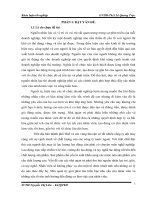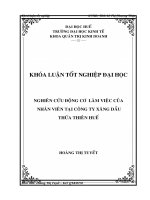VẤN DỤNG HAI học THUYẾT PHÂN TÍCH ĐỘNG cơ làm VIỆC của NHÂN VIÊN tại VIETTEL GROUP e
Bạn đang xem bản rút gọn của tài liệu. Xem và tải ngay bản đầy đủ của tài liệu tại đây (107.11 KB, 11 trang )
VẤN DỤNG HAI HỌC THUYẾT PHÂN TÍCH ĐỘNG CƠ
LÀM VIỆC CỦA NHÂN VIÊN TẠI VIETTEL GROUP
The two basic theories of motivation creating by Maslow and
Herzberg and the problem of creating incentives for employees in Vietnam
enterprises currently”
TABLE OF CONTENT:
I. BACKGROUND
II. THE THEORY OF MOTIVATION CREATING BY MASLOW AND
HERZBERG
1. The Concept of Motivation and Motivation Creating
2. Analyzing the Nature and the Relationship Between the Two Basic
Theories of Maslow and Herzberg
III. THE APPLICATION OF THE TWO THEORIES TO ANALYSE
WORKING MOTIVATION OF EMPLOYEES IN VIETTEL GROUP
IV. CONCLUSION
V. REFERENCES
I. BACKGROUND
Currently, both national and international economies are facing many
difficulties. Then enterprises who want to survive and develop in such
increasingly competititive environment need to find ways to improve their
productivity and business efficiency. In particular, labor productivity depends
greatly on the motivation of workers. If a enterprise know how to motivate its
employees, it would not only improve labor productivity, but also make them be
loyal to enterprises and contribute more to its business results. However,
currently, the research on motivation and motivation creating for workers in
Vietnamese enterprises has not got adequate attention.
II. THE THEORY OF MOTIVATION CREATING BY MASLOW AND
HERZBERG
1. The Concept of Motivation and Motivation Creating
1.1. Motivation
There are now many concepts of motivation such as:
- Motivation: The desire and voluntary of strengthening all human efforts to
achieve a specific purpose and results of the organization.
- Motivation: An inner factor which stimulates people’s efforts in the good
conditions, and produces superior results (Social and Economic Dictionary of
Vietnam).
- Motivation: The power to create, orientate, and maintain the ways of behavior.
So there are many different approaches on motivation, but they all show us the
nature of motivation to be what stimulates people to act to achieve certain
objectives.
1.2. Motivation Creating
This is an issue of management in every enterprise. If managers want to make
their companies strong, they must use methods of stimulating the employees,
encouraging them to work enthusiastically, and promoting their abilities and
creativity in their work process in order to generate high productivity and
business efficiency. This is the matter of creating motivation for workers in the
enterprise. It has said that “The success or failure of the company often depends
on how proper the company uses their staffs”.
2. Analysis of the Nature and the Relationship of the Two Basic Theories of
Maslow and Herzberg
The access to theory of motivation creating of leading economic experts,
psychologists, or theorists of management in the world is a base for Vietnamese
entrepreneur to select and apply methods to encourage their employees in the
most reasonable way.
2.1 Maslow’s Hierarchy of Needs
The American psychologists – Abraham Maslow – said that workers have 5
demands arranging in ladder from low to high: physiological needs, safety
needs, social needs, needs of being recognized, and self-improvement needs.
Accordingly, the low-level needs must be satisfied before the higher level
demands appear. These needs motivate people to perform certain tasks to be
fulfilled. So, demands become an important driving force and the impact on
individual needs will change human behaviors. The followings are the
performances corresponding to the level of labors’ demand:
Needs
Performance
Survival
Food, house, leisure
Safe
Workplace safety, guaranteed
employment, physical safety
Social
Being a member of an
organization, being allowed
to exchange, share, and
corporate
Being
Achievements are recognized
recognized
by rewards, positions, and
promotion opportunities
Self-
Development of talent, career
improvement prospects
Leaders or managers can use tools or measures to impact on the needs or
expectations of their staffs to make them more ardent and committed to the tasks
they perform.
Thus, in order to have the skills of encouraging and motivating
employees, managers should study and understand clearly their employees’
needs and have effective measures to meet them. This means they need to meet
their staffs’ demand appropriately and purposefully. For a new staff who is in
need of employment and basic income level, the creation of employment
opportunity and income for him/her is the matter to be considered at first. For a
skillful employee who has years working for the company and a lot of working
experiences with high salary, his/her need is to get higher position in the
organization. The assignment of this staff to a higher position will encourage
him/her to work more enthusiastically and effectively, etc. Currently, there is a
fact in Vietnam that many people do not want to work in joint ventures despite
of high wages paid. They just want to work in Vietnamese offices or enterprises
for much lower wages. This stems from the view that it is hard for employees to
ensure the advancement of social status in joint ventures, which means that joint
ventures with foreign businesses cannot meet the demand of promotion for these
employees... For such cases, salary or income is not a good solution to meet
their needs but the position they target is. Thus, the business owner should
consider specific circumstances to apply this theory to discover each staff’s
needs, to form, and to develop the skills of motivating employees appropriately.
2.2 Herzberg’s Theory of Two-Factor
The American theorists in management, Frederick Herzberg, tried to explain the
human motivation in a different way. He made two sets of factors motivating
workers to work and call the first set “maintenance factor”. This group works to
maintain a good state, preventing the “disease”. However, they do not make
people work better. These factors include wages, the management, supervision,
and working conditions. All workers expected to receive salaries corresponding
to their efforts. They also expect the company to be managed properly and their
working conditions are comfortable. When these factors are met, sometimes the
workers see it as evidence. But without them, they will become disgruntled and
therefore, productivity go down.
The second set of factors includes those that really bring motivation effect. They
are successes, challenges, responsibilities, promotions, and development. The
motivating factors are the ones related to job content and the maintenance
factors are the ones related to the scope of work. In the absence of motivation
factors, the workers will express dissatisfaction, laziness, and lack of interest in
working. These things cause spiritual instability.
The theory of two factors
Maintenance factors
Motivation factors
Salary and additional welfare
Meaningful job
Supervision
The feeling of completion
Working conditions
Opportunities for advancement
Management policies
Recognition of work completion
Herzberg observed that in many companies, managers try to improve
maintenance elements and expect their subordinates will be more satisfied at
work, but they were disappointed. He suggested that managers should improve
motivating factors if they desire to receive positive responses from workers.
Herzberg offers a program of diversifying work like a sample to apply his
theory of motivating elements. This program consists of making the work more
challenging by allowing employees to participate more actively and have more
control in their work. This will give them a sense of completion and being more
satisfied.
Three terms: enrich, expansion, and job rotation is often used
interchangeable despite some small differences among them. Job expansion
includes horizontal extension of the worker’s tasks by doing other similar
assignments. Enriching work includes expanding the worker’s duties vertically
by assigning them some tasks used to be done by their supervisors. This allows
him/her to self-schedule his own tasks, take more responsibilities, and develop a
sense of advancement and growth. In job rotation, workers simply changed his
job with other workers. Rotation, together with changes, breaks monotony.
Through rotation, workers have opportunities to learn new skills or understand
well a new area of a similar operation. Upon request, the workers can back up
for his colleagues.
2.3 The Similarities and Differences between the Two Theories
The two basic theories of motivation creating by Maslow and Herzberg
have different concepts and approaches to the way of creating motivation for
employees. According to Maslow, workers have 5 demands arranging in ladder
from low to high (physiological needs, safety needs, social needs, being
recognized needs and self-improvement needs). To create incentives for
employees, managers must know at which step of the need ladder the workers
are so that they can use the proper methods to meet the needs. Herzberg, on the
other hand, believed that there are two elements: maintaining factors (including
wages, management, supervision, and working conditions) and motivating
factors (including successes, challenges, responsibilities, and promotion and
development). When the maintaining elements are satisfied, sometimes the
workers see it as evidence. But without them, they will become dissatisfied,
leading to decreased production. And according to Herzberg, in order to
motivate employees, motivating factors need to be improved.
Despite the different concepts and approaches of creating motivation for
employees, needs or elements that Maslow and Herzberg raised are both around
the issues of ensuring wages, working conditions, recognition, promotion,
development, completion, etc. of the employees. The only difference is that,
according to Maslow, motivation for employees can be created by impacting on
all factors and needs, depending on each individual while according to Herzberg,
managers should only focus on the factors of achievement, responsibility,
challenge, advancement, or in other words, should impact on the demand of high
level.
III. APPLYING THE TWO THEORIES TO ANALYSE WORKING
MOTIVATION OF EMPLOYEES AT VIETTEL GROUP
Viettel is a state-owned enterprise of telecommunications under the Ministry
of Defense. After over 10 years participating Vietnam telecommunications
market, Viettel has grown significantly. From a small company with less than 200
employees, Viettel has now become a powerful economic group with 26,000
employees. Its turnovers in the year 2011 reached nearly $6 billion which took the
third place among state-owned economic groups; and its profit of nearly $1
billion was the second highest among them. Viettel is the first Vietnamese
enterprise which invested abroad successfully. There are many factors leading to
that miraculous growth, including its various breakthrough in motivating
employees:
In terms of payment mechanism, Viettel has asked for the government’s
approval to implement performance-based payment to create leverage for
attracting and retaining high-quality labor force. This is usual to a private
enterprise, but never happens in a state-owned one before. Besides, Viettel also
applies “multi-cone” payment mechanism according which experts in a
department can be paid equaling to its head; or in a company, chief engineer,
chief architect, leading specialists can be paid by the salary of the company’s
director. It’s this which helps Viettel create motivation for leading experts to be
dedicated to research work.
In terms of organization, rotation, and appointment staff of all levels,
Viettel defined specific criteria for all positions from low to high. Tests are held
annually to select staff for the positions. Any employee who see themselves to
be qualified can register to take the test, which is rare for a state-owned
enterprise in Vietnam. Opportunities for promotion, therefore, are divided
equally to all; anyone who tries and makes efforts have opportunities for
advancement and development. In addition, Viettel has fixed rotation times for
employees at all levels. One often holds a position at a location for no more than
2-3 years. For employees, they are rotated from headquarters to branches and
vice versa. This has made Viettel employees be dynamic, well-adapting to their
job.
Viettel always encourage the employees’ creative spirit. For each idea or
initiative applied, its owner will be rewarded by 5% of the benefit that it brings.
Also, collectives and individuals who exceed the business targets are rewarded
in both material and spiritual. Quarterly and annually, Viettel held celebrations
to honor and reward those who successfully completed their tasks.
Moreover, Viettel also has preferential policies on housing, transportation,
and resort every year for its employees. It concentrates on building a corporate
culture. Viettel is the common house where nobody is the number “0”. Each
staff will contribute as bricks of the common house. Viettel’s people who want
to bring happiness to their customers need to be happy in that common house
first…
So, to create incentives its employees, Viettel Group has taken many
solutions to make a breakthrough which essentially, affects employees’ needs in
appropriate ways. And the solutions have brought tremendous efficiency. Viettel
has succeeded in attracting high-quality human resources in and outside the
country, building teams of managers, technicians, and specialists which meet
requirements for developing domestically and investing abroad, rising
potentials, abilities, and arising employees’ enthusiasm on their job for the
development and sustainable growth of Viettel Group.
.
III. CONCLUSION
Vietnam is in the opening stages of integration into the world. The level of
competition for businesses in all sectors is increasingly heated. To survive and
grow, enterprises must enhance their competitive strength and improve their
productivity as well as the quality of their products and services. Especially, the key
is to develop human resources and motivate employees. There are many views of
motivating employees, but the main idea is that the managers must base on the
employees’ legitimate demands to create incentives, link the company’s
development with its staff’s promotion, and develop a favorable environment for
all employees in the company to increase their abilities and capacities.
IV. REFERENCES:
- Organizational Behaviors, Statistics Publishing House, 2008.
- Introduction to Management – Richard Pettinge.
/>- />-









